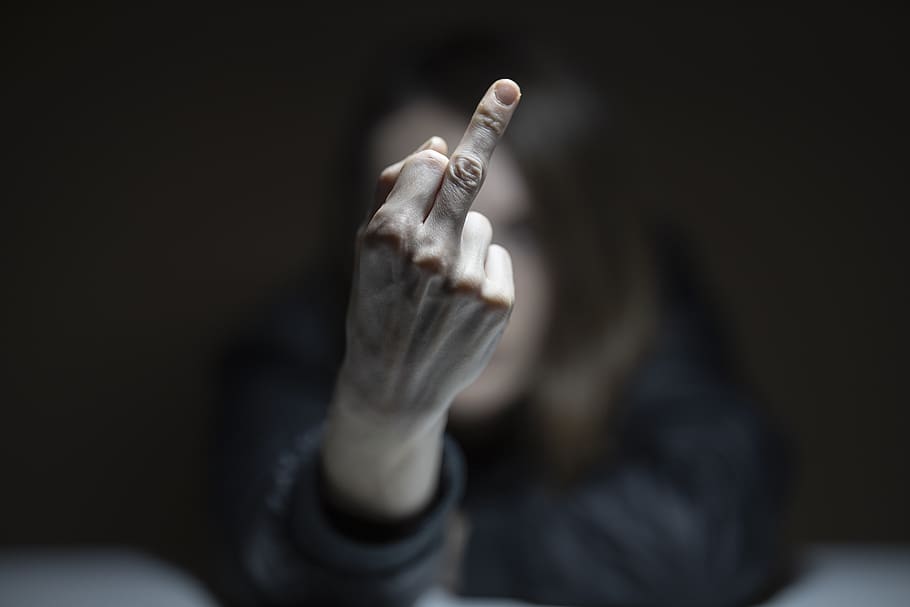Flipping the bird is a funny gesture expressed in a number of amusing ways. Some people, for instance, like to blow into their closed fist as the middle finger slowly rises as if it is being inflated. Others might hide the offensive finger under the fingers of the opposite hand, asking, “Can you hear this? Hold on, I’ll turn it up!” before presenting their digit-missive. Whichever way strikes your fancy, you should know you are not alone. As the 60s rock band The Trashmen can and did tell you, “Everybody’s heard about the bird!”
Flipping the bird meaning in ancient Greece
Who invented the middle finger? The first known use of “flipping the bird” was in ancient Greece. The Greek philosopher Diogenes, born in Sinope in 412 BC, was one of the founders of Cynicism—and a bit of a troublemaker from the start. His father minted coins for a living, and perhaps they didn’t get along so well, as young Diogenes defaced some coinage his father had given into his keeping, resulting in their exile from Sinope.
Where did the middle finger come from?
As he got older, Diogenes developed a flair for irritating others with stunts such as the time he walked around with a lit-lamp in broad daylight. When asked why, he replied, “I am just looking for an honest man, but all I find are hypocrites and scoundrels.”
While he didn’t invent it, the middle-finger gesture was very much around at this time. According to anthropologist Desmond Morris, the gesture is essentially phallic, with the curled fingers on either side representing the testicles and the raised finger you are presenting to your foe is the penis. Diogenes made what was probably the first famous usage of the ol’ hand-phallus, presenting it derisively when he heard mention of Demosthenes (a statesmen whom he deeply disliked) and proclaiming, “There goes the Demagogue of Athens!”
Flipping the bird meaning in ancient Rome
In Rome, the middle finger was not only a nasty gesture, it was an outright threat! It even had a cool Latin name: the digitus impudicus, or unchaste finger. Giving someone this sign wasn’t the flippant bird of today, however; in Rome, giving someone the finger meant threatening them with anal penetration.
Did the English “flip the bird” in defiance to the French?
One popular “origin story” for the middle finger has to do with the Battle of Agincourt in 1415. As the story goes, the French were fighting with the English and had a diabolical (and greatly advertised) plan of cutting off the middle fingers of any captured English archers so they could never taunt the French with arrows plucked in their general direction. This sounds suspicious enough to begin with for a number of reasons, but the icing on the cake of this story is that the English triumphed that day, presented their middle fingers to the French, and even hollered “Pluck Yew!” (basically saying they could still draw their bows, which were made from Yew wood).
While it’s a fun (and admittedly hilarious) story to share, there’s not a shred of truth to it. For one thing, mutilating captured soldiers was not generally the practice of the day. You didn’t want them to do it to your soldiers, and you would likely get less ransom paid to you for returning mutilated soldiers.
Finally, the whole “Pluck you” chant doesn’t hold together linguistically (though whoever said that with a straight face is aces in our book), and there is no historical record of anything of that sort occurring in the Battle of Agincourt.
The obscene hand gesture comes to America
Flipping the bird later travelled across the ocean and arrived at a place where it could thrive. In the United States, the gesture is so popular that you would be hard put not to see it in public at least once daily. In fact, the first known photo of someone giving the “one-finger salute” was taken in 1886 and shows baseball pitcher Charles “Old Hoss” Radbourn defiantly giving the finger in a Boston Beaneaters team photo.

What? You thought only modern athletes flouted the rules?
The bird in question was directed at the New York Giants who, incidentally, returned the gesture in kind by beating the Boston Beaneaters by one game (83–84) and winning the pennant, demonstrating that success is generally the best revenge (although we bet Boston got a lot of birds too that year).
Why is it called flipping the bird?
Why is the middle finger called the bird? The evolution of the etymology of the phrase is hazy. There are accounts of theater crowds giving a verbal “bird” in the 19th Century by making bird sounds to show disapproval. In Eric Partridge’s “Dictionary of Slang and Unconventional English,” actors are described to have given “the bird” by hissing like a goose. Cassell’s Dictionary of Slang highlights the use of “bird” since the 1920s and is interchangeable with the terms “raspberry” or “Bronx cheer.”
While people had been flipping the bird for millennia, it was only from the 1940s onwards that people referred to the practice as “flipping the bird.”
Since then, flipping the bird has become almost casual. But with its varied history, how it is received is generally up to the viewer. Even kids do it, though parents try to coax them to display their smallest finger instead and say, “This is a feather, because you’re not worth the whole bird.”
As every parent knows, kids don’t always listen, but at least now you know about the history of “flipping the bird”!


